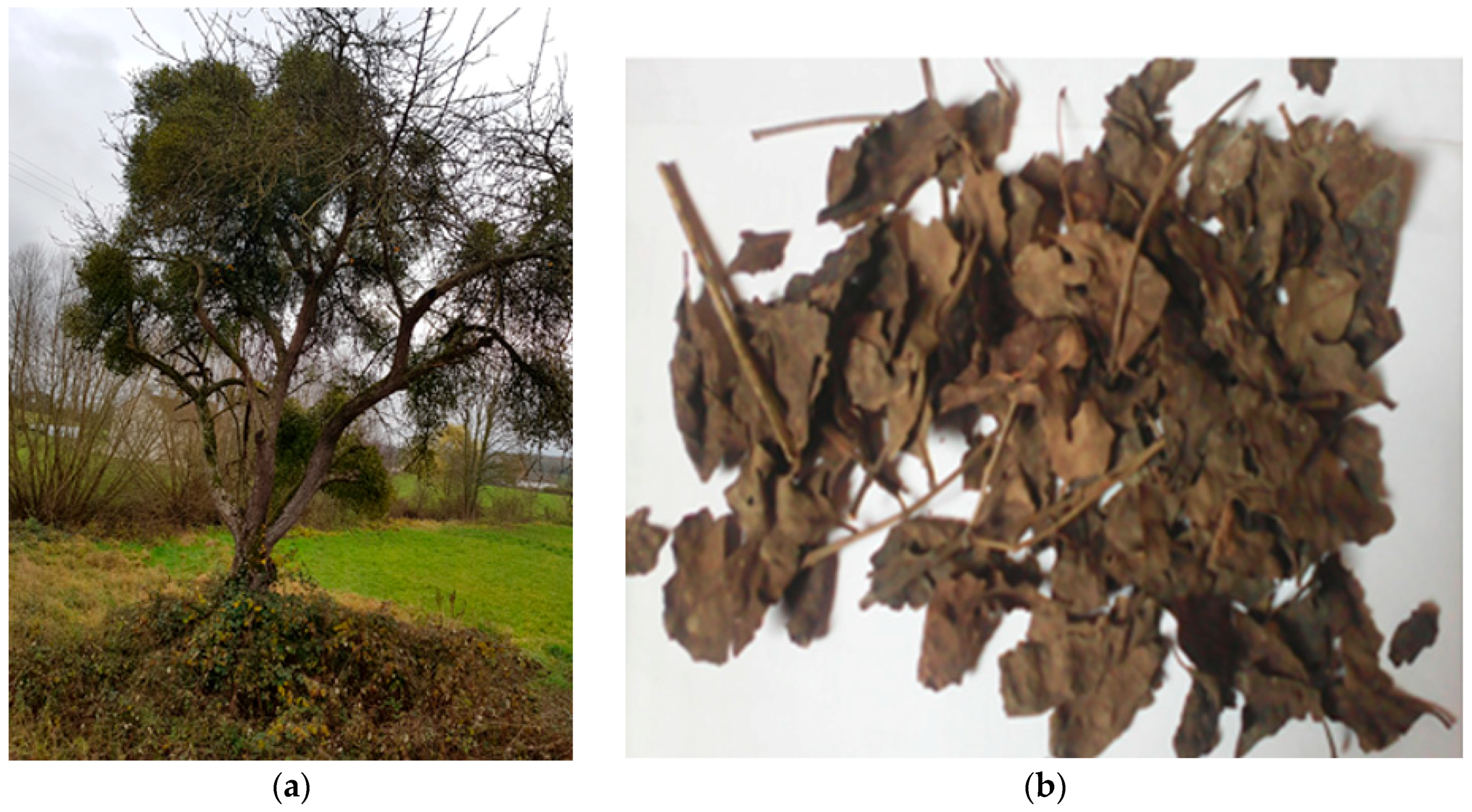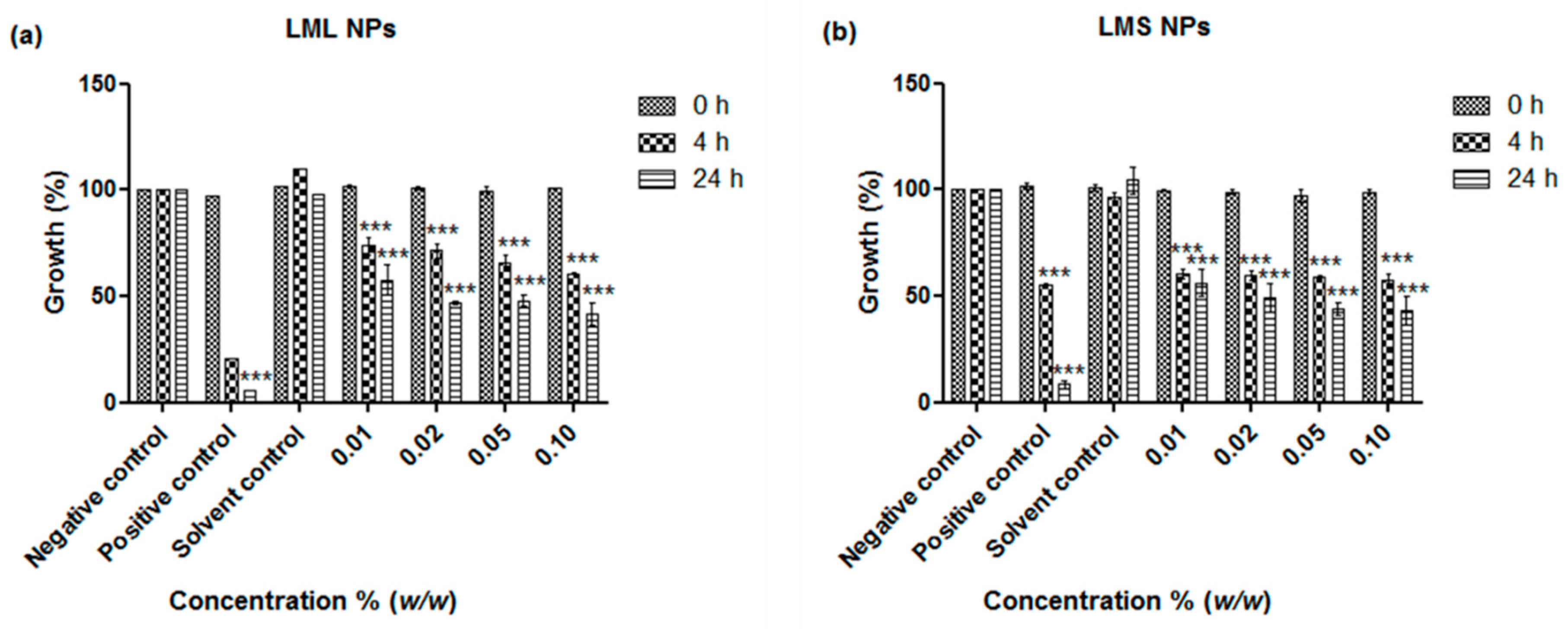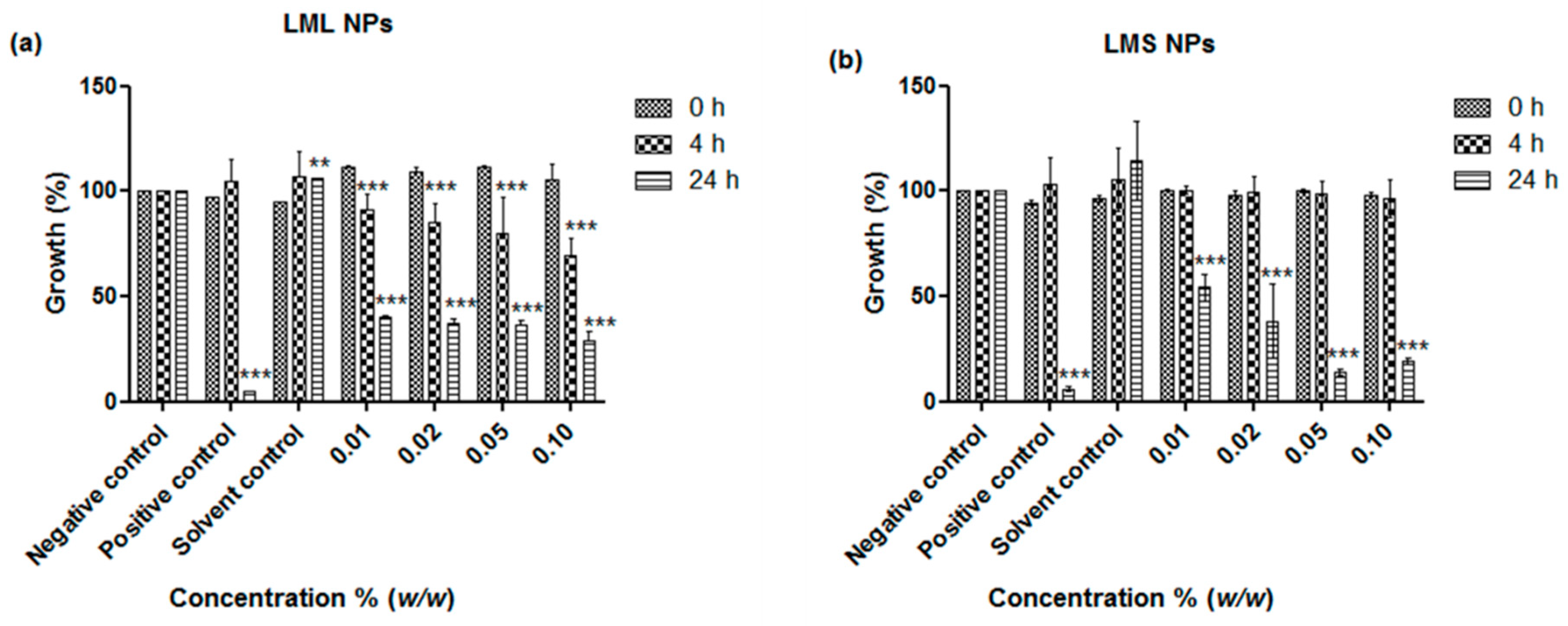Milling the Mistletoe: Nanotechnological Conversion of African Mistletoe (Loranthus micranthus) Intoantimicrobial Materials
Abstract
:1. Introduction
2. Materials and Methods
2.1. Production of Nanoparticles
2.2. Characterization of Nanoparticles
2.3. Assessment of Biological Activity
2.3.1. Determination of Antimicrobial Activity
2.3.2. Nematicidal Activity
3. Statistical Analysis
4. Results and Discussion
4.1. Production and Characterisation of Nanosized Materials
4.2. Antimicrobial Activity
5. Conclusions
Acknowledgments
Author Contributions
Conflicts of Interest
References
- Walker, B.; Mouton, C.P. Nanotechnology-and nanomedicine: A primer. J. Natl. Med. Assoc. 2006, 98, 1985–1988. [Google Scholar] [PubMed]
- Kuppusamy, P.; Yusoff, M.M.; Maniam, G.P.; Govindan, N. Biosynthesis of metallic nanoparticles using plant derivatives and their new avenues in pharmacological applications—An updated report. Saudi Pharm. J. 2016, 24, 473–484. [Google Scholar] [CrossRef] [PubMed]
- Deeni, Y.Y.; Sadiq, N.M. Antimicrobial properties and phytochemical constituents of the leaves of African mistletoe (Tapinanthus dodoneifolius (DC) Danser) (Loranthaceae): An ethnomedicinal plant of hausaland, Northern Nigeria. J. Ethnopharmacol. 2002, 83, 235–240. [Google Scholar] [CrossRef]
- Orji, F.; Nwachukwu, N.; Onyia, A.; Nkwocha, M. Phytochemical and antimicrobial properties of leaves of African mistletoe (Loranthus micranthus) on some selected microbial pathogens in Abia state, Nigeria. Glob. Adv. Res. J. Microbiol. 2013, 2, 011–016. [Google Scholar]
- Moghadamtousi, S.Z.; Hajrezaei, M.; Kadir, H.A.; Zandi, K. Loranthus micranthus Linn.: Biological activities and phytochemistry. Evid.-Based Complement. Altern. Med. 2013, 2013. [Google Scholar] [CrossRef]
- Ameer, O.Z.; Salman, I.M.; Quek, K.J.; Asmawi, M.Z. Loranthus ferrugineus: A mistletoe from traditional uses to laboratory bench. J. Pharmacopunct. 2015, 18, 7–18. [Google Scholar] [CrossRef] [PubMed]
- Griffin, S.; Masood, M.I.; Nasim, M.J.; Sarfraz, M.; Ebokaiwe, A.P.; Schafer, K.H.; Keck, C.M.; Jacob, C. Natural nanoparticles: A particular matter inspired by nature. Antioxidants 2017, 7, 3. [Google Scholar] [CrossRef] [PubMed]
- Griffin, S.; Sarfraz, M.; Farida, V.; Nasim, M.J.; Ebokaiwe, A.P.; Keck, C.M.; Jacob, C. No time to waste organic waste: Nanosizing converts remains of food processing into refined materials. J. Environ. Manag. 2018, 210, 114–121. [Google Scholar] [CrossRef] [PubMed]
- Griffin, S.; Tittikpina, N.K.; Al-marby, A.; Alkhayer, R.; Denezhkin, P.; Witek, K.; Gbogbo, K.A.; Batawila, K.; Duval, R.E.; Nasim, M.J.; et al. Turning waste into value: Nanosized natural plant materials of Solanum incanum L. and Pterocarpus erinaceus poir with promising antimicrobial activities. Pharmaceutics 2016, 8, 11. [Google Scholar] [CrossRef] [PubMed]
- Wiegand, I.; Hilpert, K.; Hancock, R.E.W. Agar and broth dilution methods to determine the minimal inhibitory concentration (MIC) of antimicrobial substances. Nat. Protoc. 2008, 3, 163–175. [Google Scholar] [CrossRef] [PubMed]
- Schneider, T.; Baldauf, A.; Ba, L.A.; Jamier, V.; Khairan, K.; Sarakbi, M.B.; Reum, N.; Schneider, M.; Roseler, A.; Becker, K.; et al. Selective antimicrobial activity associated with sulfur nanoparticles. J. Biomed. Nanotechnol. 2011, 7, 395–405. [Google Scholar] [CrossRef] [PubMed]
- Griffin, S.; Alkhayer, R.; Mirzoyan, S.; Turabyan, A.; Zucca, P.; Sarfraz, M.; Nasim, M.; Trchounian, A.; Rescigno, A.; Keck, C.; et al. Nanosizing Cynomorium: Thumbs up for potential antifungal applications. Inventions 2017, 2, 24. [Google Scholar] [CrossRef]
- Adebisi, F.; Oluwaseye, A.; Fausat, A.; Michael, A.; Adedayo, A.; Ikokoh, P.; Salisu, A.; Chukwu, N. Chemical characterization and antimicrobial activity of Loranthus micranthus Linn leaves. J. Med. Plants Res. 2013, 7, 3332–3336. [Google Scholar]
- Considine, K.M.; Kelly, A.L.; Fitzgerald, G.F.; Hill, C.; Sleator, R.D. High-pressure processing-effects on microbial food safety and food quality. FEMS Microbiol. Lett. 2008, 281, 1–9. [Google Scholar] [CrossRef] [PubMed]
- Al Shaal, L.; Muller, R.H.; Keck, C.M. Preserving hesperetin nanosuspensions for dermal application. Pharmazie 2010, 65, 86–92. [Google Scholar] [PubMed]
- Al Shaal, L.; Mishra, P.R.; Muller, R.H.; Keck, C.M. Nanosuspensions of hesperetin: Preparation and characterization. Pharmazie 2014, 69, 173–182. [Google Scholar] [PubMed]







© 2018 by the authors. Licensee MDPI, Basel, Switzerland. This article is an open access article distributed under the terms and conditions of the Creative Commons Attribution (CC BY) license (http://creativecommons.org/licenses/by/4.0/).
Share and Cite
Sarfraz, M.; Griffin, S.; Gabour Sad, T.; Alhasan, R.; Nasim, M.J.; Irfan Masood, M.; Schäfer, K.H.; Ejike, C.E.C.C.; Keck, C.M.; Jacob, C.; et al. Milling the Mistletoe: Nanotechnological Conversion of African Mistletoe (Loranthus micranthus) Intoantimicrobial Materials. Antioxidants 2018, 7, 60. https://doi.org/10.3390/antiox7040060
Sarfraz M, Griffin S, Gabour Sad T, Alhasan R, Nasim MJ, Irfan Masood M, Schäfer KH, Ejike CECC, Keck CM, Jacob C, et al. Milling the Mistletoe: Nanotechnological Conversion of African Mistletoe (Loranthus micranthus) Intoantimicrobial Materials. Antioxidants. 2018; 7(4):60. https://doi.org/10.3390/antiox7040060
Chicago/Turabian StyleSarfraz, Muhammad, Sharoon Griffin, Tamara Gabour Sad, Rama Alhasan, Muhammad Jawad Nasim, Muhammad Irfan Masood, Karl Herbert Schäfer, Chukwunonso E.C.C. Ejike, Cornelia M. Keck, Claus Jacob, and et al. 2018. "Milling the Mistletoe: Nanotechnological Conversion of African Mistletoe (Loranthus micranthus) Intoantimicrobial Materials" Antioxidants 7, no. 4: 60. https://doi.org/10.3390/antiox7040060
APA StyleSarfraz, M., Griffin, S., Gabour Sad, T., Alhasan, R., Nasim, M. J., Irfan Masood, M., Schäfer, K. H., Ejike, C. E. C. C., Keck, C. M., Jacob, C., & Ebokaiwe, A. P. (2018). Milling the Mistletoe: Nanotechnological Conversion of African Mistletoe (Loranthus micranthus) Intoantimicrobial Materials. Antioxidants, 7(4), 60. https://doi.org/10.3390/antiox7040060




